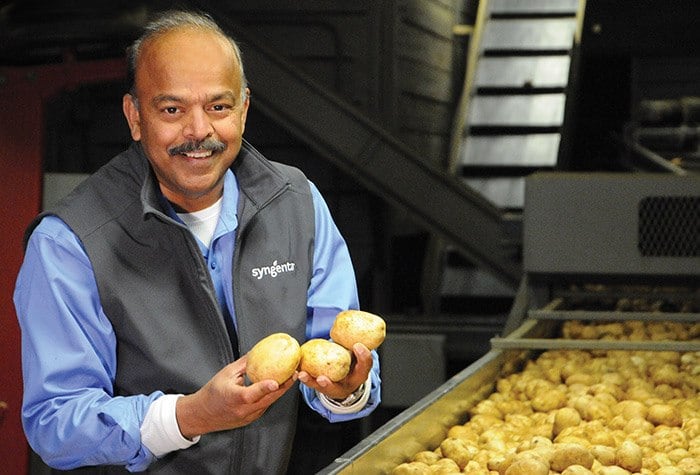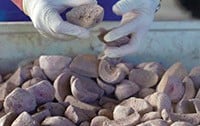Researcher Makes Potatoes His Mission in Life
Syngenta technical lead leaves an indelible mark on the industry he serves.

Sometimes, people plant their agricultural roots on the same land they spend their whole lives farming. Others transplant their roots, choosing a path unfamiliar to their families and childhood friends. Kiran Shetty, Ph.D., Syngenta technical development lead for potatoes, definitely has chosen a path less traveled. His agricultural roots extend back to his humble beginnings in southwest India and are now firmly planted in the U.S., where he has become a leading figure in the potato industry.
Over the years, Shetty has stacked up accolades: United Nations Development Program Fellowship, best scientific paper from the Potato Association of America, ambassadorship from Syngenta Technical Services and the inspiration behind the Spud Doctor agronomic video series. But his true legacy is the kindness, expertise and dedication he brings to those around him.
“Dr. Shetty was very supportive last fall at Syngenta grower meetings,” says Kasia Duellman, Ph.D., extension seed potato specialist at University of Idaho (UoI). “It’s important for us newbies to have that support from seasoned professionals.”
Early Roots
Shetty grew up on his grandfather’s farm in southwest India in a house without power or running water. His desire to help kicked in at an early age.
Shetty’s father sold crop-protection equipment and taught Shetty how the machines worked. This experience triggered Shetty’s understanding that technology could improve agriculture.
Expanding Horizons
Shetty attended the University of Agricultural Sciences in Bangalore and received the United Nations Development Program Fellowship to pursue his master’s degree. The demand for potatoes that the fast-food industry spurred caught his attention, and his teachers encouraged him to look at educational opportunities outside India. Shetty applied to UoI because of its excellent reputation for generating potato-production research.
“Pursuing education in the U.S. was like fishing,” Shetty says. “Just cast out the line and see if anything will bite. I got some bites, but funding was a problem.”
Shetty’s father wasn’t prepared to pay for a U.S. education, but Shetty’s mother sold some of her property to help cover the cost. Still, it wasn’t enough for a full semester.
“I came here with the resources she could provide, knowing she’d rolled the dice for me in a big way,” Shetty says.
In greenhouses and wheat fields, Shetty worked his way through the semester. Then Robert Dwelle, Ph.D., division chair for plant science, took Shetty under his wing. Working under Dwelle, Shetty focused on the use of shrink-wraps to extend potato shelf life. The shrink-wrapped potatoes seen in grocery stores today are a direct result of Shetty’s research.
A Professional Success
After two years in post-doctoral studies at UoI, the Overseas Merchandise Inspection Company hired Shetty to build a lab from scratch in Portland, Oregon, which he did. But when a position at UoI became available, he returned to Idaho, where he was stationed in Twin Falls as the area extension specialist for the next five years.
At the time, silver scurf, an important postharvest disease, was causing an estimated $8.6 million loss in Idaho’s fresh potato market. Learning to manage the disease was priority No. 1. Shetty, located in central Idaho, was able to study the disease on both sides of the state.
For the next three years, he surveyed growers, visited storage facilities, presented at conferences and developed solutions. As a result of his work, losses declined below $1.5 million. It was one of the major milestones of Shetty’s career.
In 1997, Novartis, a Syngenta legacy company, offered Shetty a position building the research dossiers necessary to register seed treatments for market use. Among his achievements is bringing liquid seed treatments to the potato industry. Liquids distribute active ingredients onto seed pieces more evenly than dusts and are less airborne, reducing potential breathing hazards to applicators. Prior to this development, the potato industry had used dust seed treatments, because applying liquids to seed pieces caused rot and reduced emergence. Shetty’s team broke the mold with post-application procedures and a drying agent that made liquid applications feasible for potatoes.
“I hear Kiran’s name referenced a lot when it comes to driving chemicals forward in a positive way,” says Jim Pitreau, vice president of operations at Green Thumb Farms. “He’s an advocate for potato farmers and treats everyone with respect, whether they’ve been farming for one year or 50.”
The King of Fruits
Every year, Shetty travels back to India, visiting family and friends and checking on the 2.5-acre mango farm he purchased where he grew up.
“It’s a small farm—a garden really,” Shetty says, “But it goes back to my boyhood love of agriculture. I sought out a relationship with farming because it’s where I began and want to continue.”
But he doesn’t market the mangoes. Not surprisingly, he gives them to those in need and saves a few for his family.
“Everyone likes mangoes,” Shetty says. “It’s the king of fruits.”
Over the years, Shetty has stacked up accolades: United Nations Development Program Fellowship, best scientific paper from the Potato Association of America, ambassadorship from Syngenta Technical Services and the inspiration behind the Spud Doctor agronomic video series. But his true legacy is the kindness, expertise and dedication he brings to those around him.
“Dr. Shetty was very supportive last fall at Syngenta grower meetings,” says Kasia Duellman, Ph.D., extension seed potato specialist at University of Idaho (UoI). “It’s important for us newbies to have that support from seasoned professionals.”
Early Roots
Shetty grew up on his grandfather’s farm in southwest India in a house without power or running water. His desire to help kicked in at an early age.
This @SyngentaUS technical lead leaves an indelible mark on the industry he serves. #potatoes
“As a kid, I created little irrigation systems, breaking small pipes and building channels to water my plants,” Shetty says. “Knowing I’d helped the plants produce fruit gave me a sense of accomplishment. The fruit and the brownie points it earned me at home were nice, too.”
click to tweet ![]()
Shetty’s father sold crop-protection equipment and taught Shetty how the machines worked. This experience triggered Shetty’s understanding that technology could improve agriculture.
Expanding Horizons
Shetty attended the University of Agricultural Sciences in Bangalore and received the United Nations Development Program Fellowship to pursue his master’s degree. The demand for potatoes that the fast-food industry spurred caught his attention, and his teachers encouraged him to look at educational opportunities outside India. Shetty applied to UoI because of its excellent reputation for generating potato-production research.
“Pursuing education in the U.S. was like fishing,” Shetty says. “Just cast out the line and see if anything will bite. I got some bites, but funding was a problem.”
Shetty’s father wasn’t prepared to pay for a U.S. education, but Shetty’s mother sold some of her property to help cover the cost. Still, it wasn’t enough for a full semester.
“I came here with the resources she could provide, knowing she’d rolled the dice for me in a big way,” Shetty says.
In greenhouses and wheat fields, Shetty worked his way through the semester. Then Robert Dwelle, Ph.D., division chair for plant science, took Shetty under his wing. Working under Dwelle, Shetty focused on the use of shrink-wraps to extend potato shelf life. The shrink-wrapped potatoes seen in grocery stores today are a direct result of Shetty’s research.
A Professional Success
After two years in post-doctoral studies at UoI, the Overseas Merchandise Inspection Company hired Shetty to build a lab from scratch in Portland, Oregon, which he did. But when a position at UoI became available, he returned to Idaho, where he was stationed in Twin Falls as the area extension specialist for the next five years.
At the time, silver scurf, an important postharvest disease, was causing an estimated $8.6 million loss in Idaho’s fresh potato market. Learning to manage the disease was priority No. 1. Shetty, located in central Idaho, was able to study the disease on both sides of the state.
For the next three years, he surveyed growers, visited storage facilities, presented at conferences and developed solutions. As a result of his work, losses declined below $1.5 million. It was one of the major milestones of Shetty’s career.
“I’ve known Kiran since he was an assistant professor at UoI, and I cherish the relationship,” says Neil Gudmestad, Ph.D., distinguished professor of plant pathology at North Dakota State University. “He genuinely cares about you, your family and this industry that he’s spent so much time serving.”“Dr. Shetty was very supportive last fall at Syngenta grower meetings. It’s important for us newbies to have that support from seasoned professionals.”
In 1997, Novartis, a Syngenta legacy company, offered Shetty a position building the research dossiers necessary to register seed treatments for market use. Among his achievements is bringing liquid seed treatments to the potato industry. Liquids distribute active ingredients onto seed pieces more evenly than dusts and are less airborne, reducing potential breathing hazards to applicators. Prior to this development, the potato industry had used dust seed treatments, because applying liquids to seed pieces caused rot and reduced emergence. Shetty’s team broke the mold with post-application procedures and a drying agent that made liquid applications feasible for potatoes.
“I hear Kiran’s name referenced a lot when it comes to driving chemicals forward in a positive way,” says Jim Pitreau, vice president of operations at Green Thumb Farms. “He’s an advocate for potato farmers and treats everyone with respect, whether they’ve been farming for one year or 50.”
The King of Fruits
Every year, Shetty travels back to India, visiting family and friends and checking on the 2.5-acre mango farm he purchased where he grew up.
“It’s a small farm—a garden really,” Shetty says, “But it goes back to my boyhood love of agriculture. I sought out a relationship with farming because it’s where I began and want to continue.”
But he doesn’t market the mangoes. Not surprisingly, he gives them to those in need and saves a few for his family.
“Everyone likes mangoes,” Shetty says. “It’s the king of fruits.”

